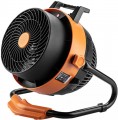—
Temperature control. The ability to change the heating temperature provided by the industrial heater. This function allows you to optimally adjust the operation of the device to the necessary conditions and heating intensity.
—
Thermostat. A thermostat is a device for maintaining the air temperature at the same level. The principle of operation of this device is as follows: when the required air temperature is reached, it automatically turns off the heating, and when it gets cold, it turns it on again until the air warms up sufficiently. The temperature of the thermostat operation, usually, is set by the operator of the heater.
—
Piezo ignition. The presence of a piezoelectric ignition system in the design of the industrial heater. In such systems, the spark necessary to ignite the fuel is generated by the operation of a piezoelectric generator, and its operation is based on the use of a special material that, when bent, generates an electric current. It means that no external power is required for ignition — the necessary energy is generated by the operator himself when the button is pressed. In addition, piezoelectric systems are considered very convenient for several other technical reasons. They are found mainly in gas industrial heaters (see "Power supply") because, for diesel fuel, such ignition is poorly suited.
—
Complete fuel combustion. This feature is found in gas and diesel models (see "Power supply"). It means that the fuel in the combustion chamber of the heater burns out completely, without forming soot and other by-products and practically without creating unpleasant odours. In addition, it has a positive effect on efficiency. This feature is especially important for diesel units because diesel and many types of liquid fuels are "dirtier" than gas and more prone to soot. Smokeless combustion facilitates the use of heaters in rooms where there are people — however, note that it does not cancel the requirements for good ventilation, since combustion products still need to be removed from the air.
— Fan mode. The ability to operate the heater in the ventilation-only mode, when the device circulates air but does not warm it up. The purpose of this function is obvious: situations when the room is already warm enough, or heating is not required for other reasons.
— Fuel level indicator. The presence in the design of a diesel heater of a sensor that signals the amount of fuel in the tank. The design and operation of this sensor may vary from model to model: in some devices, it constantly displays the remaining fuel; in others, it plays the role of an alarm and turns on only when the fuel level drops below a certain value. However, this feature makes it easier to monitor the condition of the unit and prevents troubles associated with unexpected emptying of the tank.
— Air filter. The presence of an air purification filter in the design of a diesel heater. One of the “weaknesses" of such units is the nozzles that supply the fuel-air mixture to the combustion chamber; contaminants that enter these nozzles clog them and can even disable them. The air purification filter prevents such troubles: it traps dust, sand and other mechanical impurities, ensuring stable operation and durability of the injectors.
The presence of a
display in the design of the industrial heater. Additional service information can be shown on the display: operating mode, power, thermostat settings, fuel remaining (see "Features"), error messages, etc. The specific set of display capabilities in different models may vary markedly, but this feature makes control more convenient and intuitive.

